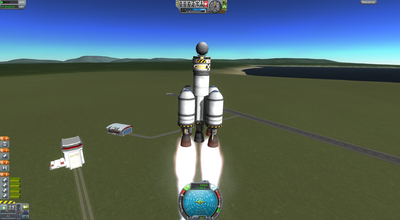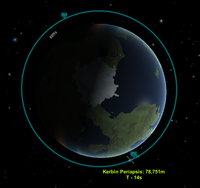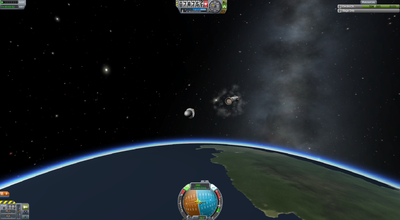Difference between revisions of "Tutorial: Sputnik 1/zh-cn"
m |
(→Lift-Off) |
||
| Line 34: | Line 34: | ||
== 任务分段 == | == 任务分段 == | ||
| − | === | + | === 起飞 === |
| − | [[File:Sputnik-liftoff.png|400px| | + | [[File:Sputnik-liftoff.png|400px|火箭点火起飞]] |
| − | + | 在开始飞行之前,最好先打开 RCS 和 SAS 开关,这样可以更好的控制火箭。另外,点击导航球下方的表盘,从地面模式切换到轨道模式(其读数应为 “Orbit 174.5m/s“)。 | |
| − | + | 本段飞行的目标就是尽快离开大气层。地表附近的大气层会带来阻力从而消耗更多的燃料,因此我们的飞行方向应该是垂直向上尽快脱离这个阶段。 | |
| − | + | 准备完毕之后,把推力调整为最大,按空格键,一级发动机点火起飞。注意观察导航球,尽量把火箭方向保持在垂直向上的位置。在第一级火箭燃料耗尽之后,按空格键进行第一级火箭的分离,随后二级火箭发动机点火(别再多按空格键,否则火箭会进行错误的分离,你的任务也就提前结束了)。 | |
=== Gravity-Turn === | === Gravity-Turn === | ||
Revision as of 14:40, 1 June 2013
| “ | 太空时代来临 —— 第一颗人造月亮正在绕地球飞行。 — Daily Express |
” |
欢迎来到本教程的第一课,我们将在这里重现地球太空飞行历史上的一系列重要任务。在阅读本指南之前,你最好能先完成游戏自带的教程,以掌握基本的操作。
我们的第一个任务是“斯普特尼克”的发射,这是第一个进入环绕地球轨道的人造物体。1957 年,苏联成功的发射了“斯普特尼克”,并震惊了整个世界。当美国各军事机构的航天计划能给人留下印象的还是发射场的爆炸“非计划性航天器解体事件”,没有人能够料到苏联人已经在火箭科学中遥遥领先。“斯普特尼克”在太空中发出的“哔哔”声,全世界的业余电台都能接受到这一信号,对于西方航天界而言,它无疑是振聋发聩的巨响,他们从此意识到应该严肃面对太空飞行了。现在,我们就来在 KSP 中重现这一任务。
我们要向太空发射一颗卫星,并让它进入稳定的轨道。就此而言,太空的定义是从 100 km 高度开始的,因为这里的大气层已经稀薄到不至于影响飞行器的地步,因此,飞行器可以于此长久的保持在轨状态。
Contents
运载火箭设计
在这个任务中,我们会重新制造苏联的 R7 型火箭。它的第一级由四台发动机组成,第二级为单发动机,卫星是末级负载。
- 负载端
- 1x Stayputnik Mk. 2
- 1x Z-500 充电电池组
- 第二级
- 1x TR-18A 型级间分离环
- 1x FL-R25 型 RCS 燃料舱段
- 4x RV-105 型 RCS 喷嘴单元 (对称形径向安装)
- 1x FL-T800 型燃料舱段
- 1x LV-T30 型液体燃料火箭发动机
- 第一级
- 4x TT-38K 型径向分离机构
- 4x FL-T400 型燃料舱段
- 4x 流线形鼻锥
- 4x LV-T30 型液体燃料火箭发动机
我们在负载级安装了电池组,因为 Stayputnik 组件需要外部能源来运作。在上升段,发动机可以产生电源,但入轨后它就需要自身的电源装置来保持运行。它本身的电源容量为 5 单位,大概只能维持其运行 2 分钟,然后它就是废铁一块了。而 Z-500 可以提供 500 单位的能量,足够在几个完整的轨道周期维持其运转。或许 Z-100 的重量相对更合适,但不幸的是在我们这儿它无法在火箭上正常安装。
假如你希望让卫星看起来更加逼真,你可以沿卫星的圆周径向安装四个 Communotron 16 天线,其方向为斜后方 45° 角。需要记住的是,这些天线实际上没有什么作用,只会增加重量,并提高任务难度而已。
另外火箭的流线形鼻锥也只是起到改善外观的作用,因为就目前的 KSP 版本(0.18.4)而言,空气阻力并没有实际的作用。火箭组件的增加只能带来重量的上升,而且无法起到降低空气阻力的效果。如果不追求外观,你完全可以忽略掉它。
任务分段
起飞
在开始飞行之前,最好先打开 RCS 和 SAS 开关,这样可以更好的控制火箭。另外,点击导航球下方的表盘,从地面模式切换到轨道模式(其读数应为 “Orbit 174.5m/s“)。
本段飞行的目标就是尽快离开大气层。地表附近的大气层会带来阻力从而消耗更多的燃料,因此我们的飞行方向应该是垂直向上尽快脱离这个阶段。 准备完毕之后,把推力调整为最大,按空格键,一级发动机点火起飞。注意观察导航球,尽量把火箭方向保持在垂直向上的位置。在第一级火箭燃料耗尽之后,按空格键进行第一级火箭的分离,随后二级火箭发动机点火(别再多按空格键,否则火箭会进行错误的分离,你的任务也就提前结束了)。
Gravity-Turn
When you've reached an altitude of 10km (should be shortly after igniting the 2nd stage), air resistance becomes much less. Now we start to build up vertical speed so we get fast enough to get into a stable orbit. Do this by tipping your rocket into the direction of the yellow direction marker on the nav-ball (90° eastwards). While your rocket faces the direction marker, the marker will slowly fall towards the horizon. This is good. Keep your rocket pointed at the direction marker, so it slowly tips towards the horizontal plane.
Getting into a circular orbit
While you perform your gravity turn, switch to the map view so you can see your flight path and you apoapsis. You can switch on the nav-ball in orbital view by pressing the comma-key on the num-pad. Do this so you don't get off-course. Your goal now is to get your apoapsis to about 100km. We need some additional height because we aren't out of the atmosphere yet, so we will keep losing some height due to atmospheric drag.
When you reached your apoapsis, perform a prograde boost - orient your rocket horizontal in eastern direction and burn your remaining fuel to get into a circular orbit. Should you run out of fuel, remember that you likely still have plenty of monopropellant left from the ascend. Press H to use it to accelerate forward. It doesn't do much, but it can be enough to give you the crucial last few m/s to get into a stable orbit.
Dropping the payload
After you are in orbit, drop your payload using space. Thanks to the powerful separator it will be blasted forward while the engine stage drifts behind. Congratulation, you just made space history. Go into time-warp and watch your satellite orbit Kerbin gracefully.
What next?
Unfortunately the satellite still has a limited lifetime due to energy use. To extend its life further it needs some kind of energy source in form of photovoltaic panels or a Radioisotope generator. When you have a sustainable energy supply, you can also add some scientific payload like accelerometer, barometer, thermometer or gravimeter. Note that all of this will increase weight and atmospheric drag, so you will need to add some more tanks to your rocket.
When unmanned satellites become boring, it's time to get to the next stage of space exploration: your first manned mission.





